Ten Weeks On The Camino: Nick Stark walks through the vineyards of Rioja and enjoys the magic of Burgos
Logrono to Najera 17m
By the time you’ve settled into your third week walking the Camino Frances, your body should have adjusted to the demands you’ve been making of it.
Your legs and feet will already have about 150m in them and your blisters should have transformed into callouses, unbothered by chafing from your boots. As the body adjusts, the mind tends to focus more on the gorgeous landscape surrounding you and that 15lb backpack starts to feel a lot less onerous. And the prospect of 350-odd miles more doesn’t seem so daunting.
At least that’s how it worked for us.
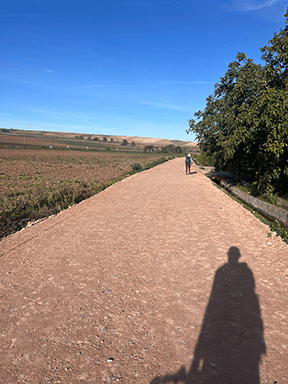
We bid a fond farewell to Logrono and set out for Najera, a memorable step of 17 miles through this region’s famed red earth, rolling hills and extensive vineyards. This is Rioja country, the area getting its name from the local river, the Rio Oja, which we cross several times en route to our destination. There are plenty of long desolate stretches of pathway here, with barely a pilgrim in sight ahead or behind, but every 90 minutes or so we came to a hilltop town to get fed and watered. The cafés and bars in this part of the world depend heavily on pilgrim traffic, and location really does matter: first bar in town was usually jammed with pilgrims eager to put down their packs and whet their whistles, but the patient pilgrim who could bear to turn the next corner or walk another two minutes was usually rewarded with bigger smiles, no lines and slightly cheaper prices.
Najera to Santo Domingo 13m
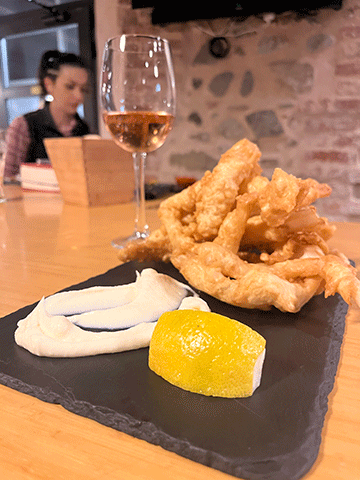
Our destination for the night was the ‘Hospedaria Cistercense’, which in plain English means a hostel run by Cistercian nuns. Although I was intrigued by this prospect it turned out to be one of our least stimulating stays. The nuns in their habits were brisk and businesslike, in fact far less friendly than the entrepreneurial hospidaleros we were used to dealing with. To make things even less enticing, the building itself is a dreary 1960s-style former student lodging devoid of any charm or individual identity. And their morning desayuno (breakfast) featured the worst coffee I can ever remember drinking. We had Fortunately the town has a bustling strip of bars and restaurants, so at least dinner wasn’t a bust. A huge plate of fried rabas (squid) with an aioli schmear and a glass of crisp white wine cost about 6 euros so we went to bed happy.
Santo Domingo to Belorado (14m) and Belorado to Villafranca (7m) As we edged westward and the miles fell away under our feet, the vineyards of Rioja began to yield to fields of wheat and other arable crops. We were entering Spain’s breadbasket and the region of Castille y Leon, an historic and large swathe of the country that comprises its largest autonomous region and where were would spend the next two weeks. From a walking perspective it was an easy section, with rolling hills and mostly deserted paths between towns, with the most pressing issue being to avoid the tractors driven by local farmers eager to harvest their crops before the coming rains. Fields of sunflowers were everywhere, but they were all a few weeks past their peak, their wan and brown faces turned sadly earthwards. The town of Belorado is a picture-perfect little place wedged between two small mountains dotted with caves favored originally by hermits and early Christians. And the food at our hotel, The Huella Del Camino, was among the best we found on the Camino, especially a huge Pilgrim’s Breakfast which included an omelette, Iberico Ham, cheese, yogurt, fruit, orange juice and a Cafe con Leche. Just the thing to set you up for a day on the trail. But the delightful Belorado was a complete contrast to our next stop, Villafranca, a town whose existence relies chiefly on its role as a crossroads through which Spanish semi-trucks thunder laden with farm produce. Good only for an overnight stop and a quick exit at sunrise.
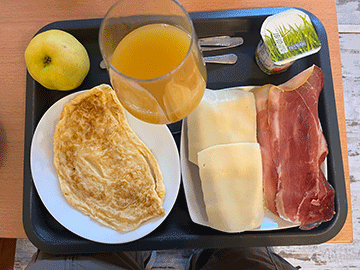
Villafranca to Atapuerca (11m) Things started to look up again, so to speak, on the long uphill climb out of Villafranca through a gloomy oak and pine forest which looks positively primordial when viewed from the path. In medieval times this was a bandit hideout used to prey on pilgrims, prompting the Knights Templar to build a fortified village nearby from which to sally forth and protect the faithful. There is also a monument to dozens of unarmed villagers killed by General Franco’s troops during the Spanish civil war, a grim reminder that this country was not always as civilized as it now seems. And for anthropologists there is an interesting excavation in the nearby Atapuerca mountain range, where bone fragments from around 800,000 years ago provide the oldest known evidence of hominid settlement in Western Europe.
Atapuerca to Burgos (12m)
As we approached the city of Burgos we could feel the landscape flattening out, the mountains fading away and the biodiversity of the farming dwindling down to a single crop: wheat. The approach to Burgos takes the best part of half a day and is very pleasant if you take the Camino route by the river, where you can enjoy shade and quiet right until you stumble across the entrance to the city’s Casco Antiguo (Ancient District), which is an absolute delight.
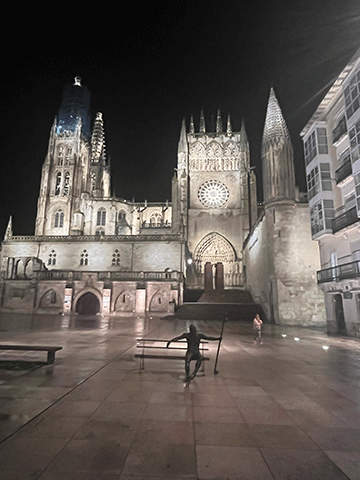
Burgos is justly famous for two things: its magnificent cathedral, which dominates the old town and is considered by many second only to those in Seville and Toledo for its splendor; and for its most famous son, Rodrigo Díaz de Vivar, better known as El Cid, scourge of the Moors during the Reconquista, as Catholic Spain re-established its supremacy over Islam, and characterized forever by Charlton Heston in the movie of the same name.
As with Logrono and Pamplona, the side streets are characterized by sinous and winding alleyways full of bustling bars and cafés selling low-price local wine and fabulous tapas. The food here is classic Castillian: dominated by meats such as lechazo (suckling lamb), cochinilla (suckling pig), jamon iberico (the classic Spanish cured ham) and morcilla (blood sausage. The meat theme continues with their famed cocido (a hearty meat and vegetable stew) and the robust but challenging callos (tripe soup). Not surprisingly, red wines are heavily favored given their meat-driven menu, with the Tempranillo regions of Ribera del Duero, Toro and Rueda the most popular.
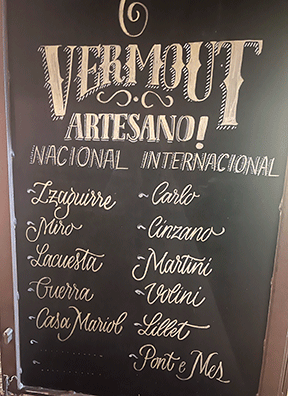
If you do find yourself in Burgos, do not miss whetting your whistle at the Victoria Vermouteria, a fabulous neighborhood bar located just to the right at the old town’s entrance. The place boasts a large selection of regional artisanal vermouths, which the locals typically enjoy with an ice cube, a slice of orange and an olive. The buzz is lively, the service prompt, and best of all, every evening at 10pm everything comes to a halt as a brass soundtrack fills the air and the locals belt out a rousing rendition of the local Burgos anthem. Magical stuff.
